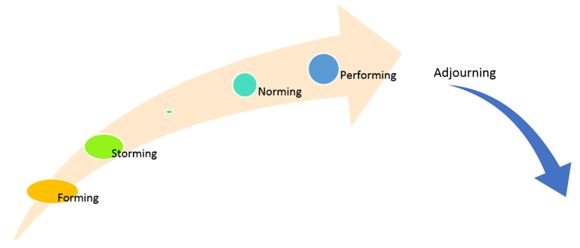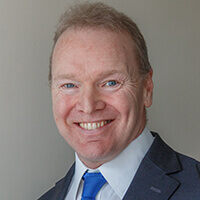Tuckman's Five Stages of Team Development
Tuckman's Five Stages of Team Development
In 1965 Bruce Tuckman presented his description of the four stages of team development and called them 'Forming, Storming, Norming, and Performing'. In the 1970s he added a fifth stage which he called 'Adjourning'.

Forming
This stage denotes a group of people when they first come together to form a team.
They don't know each other, they don't know what the plan is, nor the standards which are expected of them. Team performance is at its lowest point.
Storming
This stage denotes the creation of social hierarchies, where the various personalities jostle with each other to determine their positions in the hierarchy of the group. This is a period of conflict as dominant personalities clash, and submissive personalities submit.
As the social hierarchy takes shape the work begins to flow and the productivity of the team improves.
Norming
This stage denotes the habitualisation of the social structures as people begin to settle down. Each person "knows their place" and what is expected of them. The productivity of the team improves still further.
Performing
This stage denotes the peak performance of the group, where everyone is in their "right place" and each person is perfecting their performance in their particular role, causing the productivity of the team as a whole to reach its zenith.
Adjourning
This stage denotes when the teams project is ended, and the team disbands, either temporarily or permanently. This marks the end of the team, and team performance ceases to exist.
Is the Tuckman's team model of value?
The model is of some value if leaders want to know what to expect.
It is not much value if leaders want to know exactly what to do and say in order to get the best performance from the team, at any stage of the process.
Descriptive verses Prescriptive theories.
Theories come in two main types, Descriptive and Prescriptive.
- Descriptive theories describe what happens.
- Prescriptive theories prescribe what actions we should take, in order to get the best results.
Most people need to know what to do and say, in order to get the best results, so most people need to learn prescriptive models.
Tuckman's model is descriptive, (not prescriptive), it does NOT give definite leadership responses to the five stages.
Consequently, we can categorise the Tuckman's Model as being "Interesting, but of a limited practical value".
Leaders need to learn exactly what to do and say
To get the best results, leaders need to learn exactly what to do and say. For this reason, there are better leadership models than Tuckman.
If you want to learn exactly what leaders should do and say, in order to get the best performance from the team, then please attend our Leadership and Management training course.
Definition: Tuckman model
In business team leadership, the Tuckman model is a group-development model that explains how any work team moves through five clear stages-Forming, Storming, Norming, Performing and Adjourning-in a set order, shows the social and task patterns at each stage, and covers teams from start to end so leaders can predict changes in performance.
Show CG4D Definition
- Outlines five named stages of team growth: Forming, Storming, Norming, Performing and Adjourning
- Treats the stages as sequential and universal to work teams
- Provides descriptive social and task behaviours for each stage
- Spans the team’s full life cycle from formation to disbandment
Article Summary
The Tuckman model maps every team’s life: Forming, Storming, Norming, Performing and Adjourning. It shows leaders what to expect, yet makes clear that only planned actions and clear words turn any group into a high-performance team.
Frequently Asked Questions
Here are some questions that frequently get asked about this topic during our training sessions.
What happens in the Forming stage of the Tuckman model?
Why is the Storming stage often full of conflict?
How long can a team stay in each Tuckman stage?
Can a team jump to Performing without Norming first?
What is the main weakness of the Tuckman model for leaders?
How does the Adjourning stage affect team morale and output?
Is the Tuckman model descriptive or prescriptive?
Thought of something that's not been answered?
Did You Know: Key Statistics
Gallup’s 2023 State of the Global Workplace report shows only 23% of employees are engaged worldwide, yet teams whose managers provide clear direction and feedback achieve an 18% jump in productivity. McKinsey & Company’s 2022 “Performance through People” study found cross-functional teams that undergo structured team-development training record a 30% higher project-success rate than teams that do not.Blogs by Email
Do you want to receive an email whenever we post a new blog? The blogs contain article 5-10 minutes long - ideal for reading during your coffee break!
Further Reading in Teamwork
-
A Good Team Builder
Learn how goal focused leadership turns team building into profit. Keep diverse staff united around one clear goal and watch cohesion, trust and results rise.
Read Article > -
Team Problem Solving
Learn the Mastermind Principle for team problem solving: form a small, diverse group, set a shared goal and watch creativity rise, speed and profits soar.
Read Article > -
The 7 People Management Skills
Learn seven key people management skills; blend logic, emotion, organisation, fairness, sales and role modelling to create engaged, high-performing teams.
Read Article > -
How can I improve team performance?
Boost team performance with seven habits: goal focus, clear talk, sound plans, positive action and a feedback culture. Discover more in our two-day course.
Read Article > -
Coaching and Mentoring Skills
Learn non directive coaching and mentoring skills. Use role modelling and coaching questions to replace directive teaching and speed up goal achievement.
Read Article >
Looking for People Management Skills Training?
If you're looking to develop your Teamwork Skills, you may find this People Management Skills Training Course beneficial:
Open Training Course Pricing and Availability
Next Open Course Starts in 20 days, Cheltenham Gloucestershire, places available






